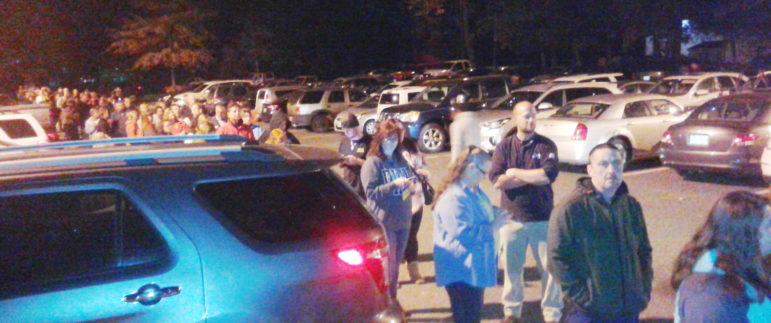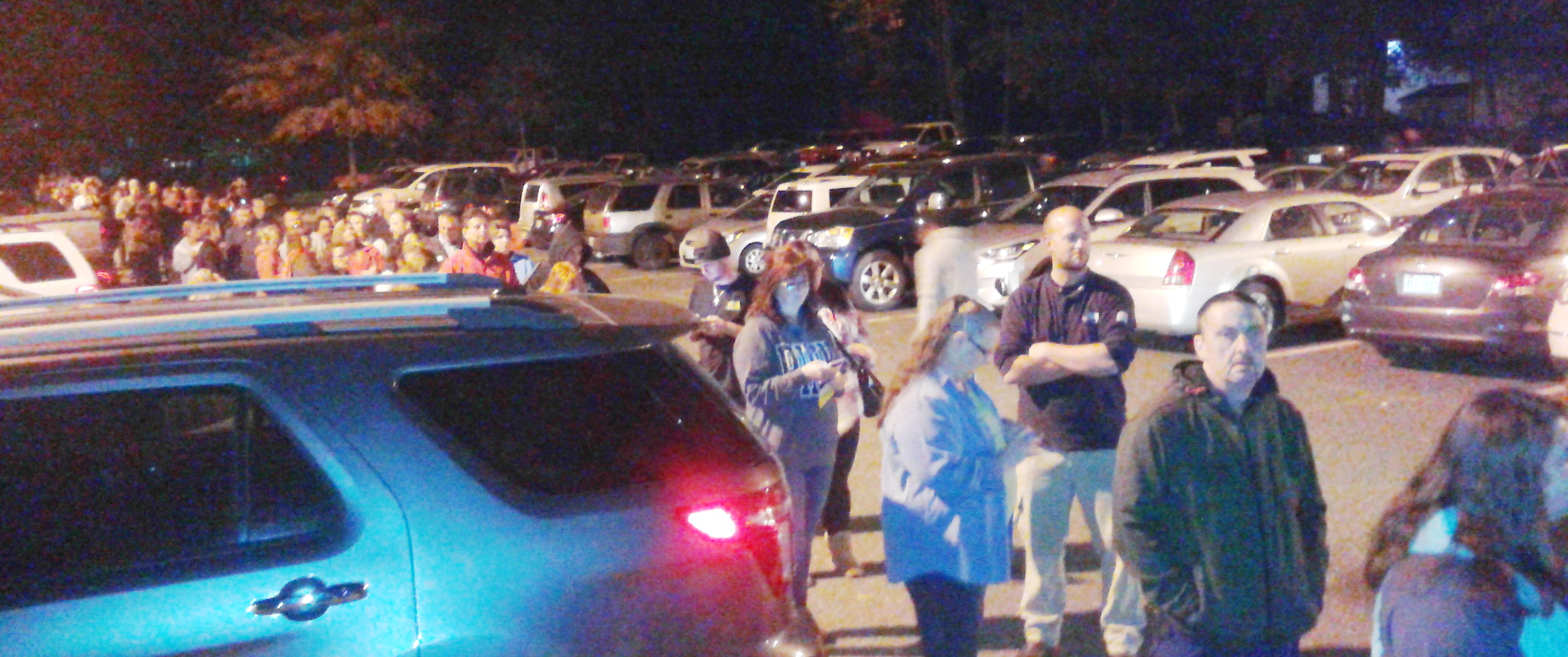By Glynis Kazanjian and Len Lazarick
MarylandReporter.com

Hundreds of voters in line at Battle Grove Elementary School in Dundalk a half hour before the polls were to close on Election Day, Nov. 8.
There were long lines at some polling places on Election Day, and hundreds of voters waited for hours, particularly in Baltimore County. But there is no evidence of a partisan conspiracy, as some Republicans believed, just a shortage of scanners.
Before the last voters cast ballots after 10 p.m. on Election Day, Maryland Republican Party Executive Director Joe Cluster was up in arms over the long waits that were exasperating some voters throughout the state.
Cluster, along with other Republican officials, received numerous calls from disgruntled voters throughout the day and into the evening, when he and others attended a Republican watch party at the BWI Marriott.
Any voter in line by the 8 p.m. closing time was allowed to vote, but some waited for hours to mark their paper ballots and then stood in another line to scan them. Others just gave up.
“I’m concerned about the distribution of machines,” Cluster said. “Election Day was a fiasco! There was probably one [scanner] at every polling place. We definitely need more. The Board of Elections needs to make sure we find the money to put more scanners in the polling precincts.”
This year Maryland introduced a new paper ballot system for the primary and general elections. Under the direction of State Election Administrator Linda Lamone, a formula for allocating ballot scanners to precincts was set.
According to local election officials, voting precincts with 4,000 registered voters or less are allocated one ballot scanner. Precincts of 4,001 or more voters, get two.
No budget for extra scanners
“One scanner per precinct is pretty much standard throughout the country,” said Nikki Charlson, deputy administrator of the State Board of Elections. “We had a lot of experience with scanners,” since 19 counties used them with paper ballots for several elections before 2002.
Local election boards, however, were allowed to request additional scanners.
Initially, the State Board had no money to lease more scanners. However, the Maryland Association of Counties was able to persuade Gov. Larry Hogan and the Board of Public Works for an additional $525,000 for more scanners, with the costs split 50/50 between the state and the counties.
Some of the larger voter jurisdictions in Maryland, such as Montgomery, Howard and Prince George’s Counties did request more scanners, but Baltimore County did not.
Baltimore County Board of Elections President Paul Lubell, R, said as far as he knew, Baltimore County got a fair number of scanners from the state, but he had relied on experienced staff to handle the mechanics of Election Day.
Baltimore County unaware, Montgomery, PG asked for and got more
“I was told by one board member and also by Katie Brown, the elections director, about the one scanner [per] 4,000 voter formula,” Lubell said. “If I had known Montgomery County had two [scanners] for each precinct, I would have been more proactive in pushing for additional scanners. To the best of my knowledge, the formula had to be strictly adhered to.”
After studying similar voting districts throughout the country that used a comparable paper ballot system, Montgomery pushed local and state officials for funding to secure more scanners for Election Day.
All of Montgomery’s voting precincts had two scanners per precinct. Some had three. In Prince George’s County, Elections Director Alisha Alexander said the state’s allocated amount fell short. She wanted two scanners for every precinct, but the cost was too high. So she settled on half of the precincts.
“I know there was a prescribed formula I was not comfortable with,” Alexander said. “I requested additional scanners for precincts with over 2,500 voters. Some precincts had three. In many instances those had between 4,500 and 5,000 registered voters. I got an additional 85.”
Howard County Board of Elections Director Guy Mickley said Howard deployed one scanner per precinct under 2,500 voters, and two scanners for precincts over that.
Democratic precincts affected too
While many large Republican voting precincts in Baltimore County fell victim to long lines due to the single scanner issue, many Democrat-heavy precincts did too.
Baltimore County Republican Party Chairman Al Mendelsohn said he did not think partisan politics was at play.
“In Baltimore County, I don’t think that there was any guile involved,” Mendelsohn said. “I think that the instruction was from Linda Lamone, who has proven herself over and over again to be a really incompetent administrator for the state of Maryland.”
Some waiting times for lines in Baltimore County averaged between one and two hours, according to various sources, including radio reporters and callers, an ACLU election day hotline and direct complaints to Republican Party officials.
At Battle Grove Elementary School in Dundalk, Mendelsohn and other observers estimated over 400 people were still in line at 7:30 p.m., and people were still arriving he said.
Rodgers Forge Elementary school in Towson had a two-hour line, a Timonium precinct had a one-and-a-half hour line, and at Cromwell Valley Elementary School voters had to wait two-and-a-half hours due to a broken scanner.
There were also long lines reported at Dogwood Elementary School, as well as Grace Lutheran Church in Lutherville, where voters with completed ballots waited for them to be scanned. At Grace Lutheran the wait time was said to be between 75 and 90 minutes.
And at Edgemere Elementary School there was a two-hour wait after several scanners broke down.
Perry Hall High School, Perry Hall Elementary School, Kingsville Elementary School and precincts at Church Lane Elementary Technical School also reported long wait times.
No partisan motive seen
“I don’t believe partisan politics was involved in the allocation of scanners,” said Maryland State Board of Elections Chairman David J. McManus, R. “We will look into the need to acquire more scanners. All of these issues will be addressed at upcoming meetings.”
All local election boards and the state board, as well, became majority Republican after Republican Larry Hogan was elected governor.
Timonium resident Alice Rhodes said she was flabbergasted at the response she got after she reported her 90-minute wait to a customer service representative for the Baltimore County Elections office.
“They said, ‘Well we have an historical amount of people voting in this election and because of that you’re going to expect some lines,'” Rhodes said. “And I said, no I expect the correct amount of scanners to deal with the amount of people voting in this historical election. It’s not rocket science. If you know you’re going to have a historical amount of people voting, you should have extra scanners.”
While the nation experienced a historical election with two widely unpopular presidential candidates, Maryland did not experience a historical turnout.
Lamone expected an 80% voter turnout, according to media reports, but only 66% of eligible voters cast votes.
Glynis Kazanjian can be reached at [email protected] and Len Lazarick can be reached at [email protected].




Recent Comments